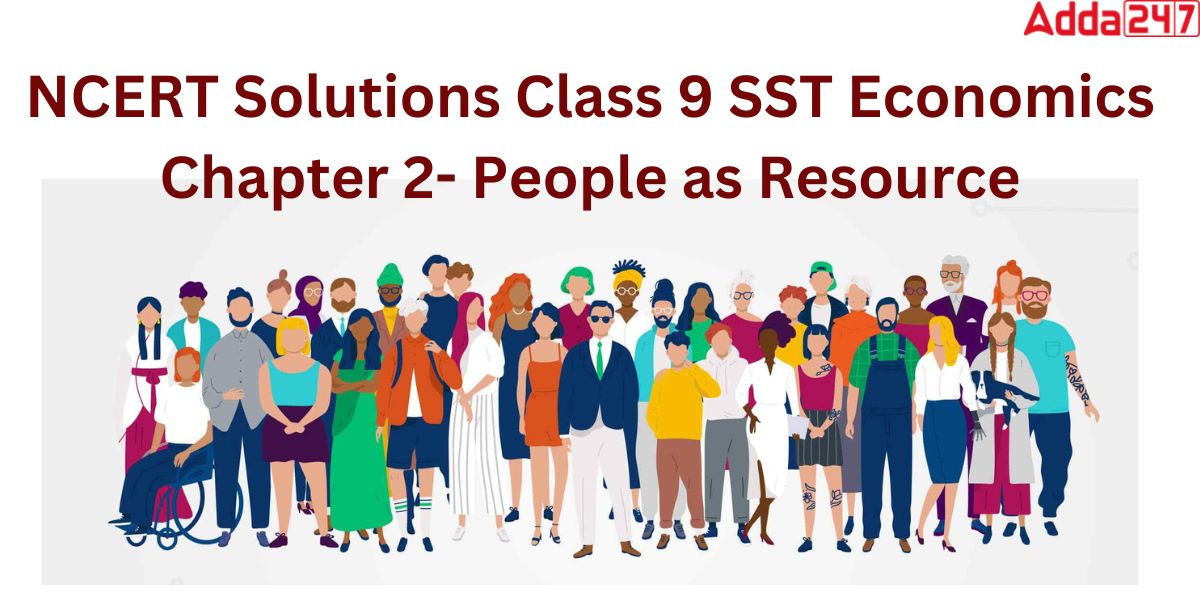NCERT Solutions for Class 9 SST Economics Chapter 2 People as Resource
NCERT Solutions for Class 9 SST Economics Chapter 2- People as Resource notes are provided in this article. NCERT Solutions for class 9 is the finest resource for getting a high class 9 examination score. Adda247 Expert faculty team prepared NCERT Solutions for Class 9 SST Economics Chapter 2- People as Resource exercises of that chapter for a better grasp of the topics. These NCERT Solutions answer all questions in an easy and simple manner. These solutions will help you understand the concepts covered in the chapter completely. By writing these answers in the exam students will undoubtedly be able to achieve high scores. Keep learning with Adda247.
NCERT Solutions for Class 9 SST Economics Chapter 2 People as Resource Pdf
NCERT Solutions for Class 9 SST Economics Chapter 2- People as Resource Pdf is given in pdf format so students can easily download it for future use. Click here to download NCERT Solutions Class 9 SST Economics Chapter 2 People as Resource
Class 9 SST Economics Chapter 2 People as Resource: Video Explanation
Class 9 SST Economics Chapter 2- People as Resource: Summary
In class 9 SST Economics Chapter 2- People as Resource introduces Human Resources. Chapter 2- People as Resource described the population as a resource for the economy rather than a liability. It also discusses the function of educated people and their contributions to society.
1. Economic Activities by Men and Women
2. Quality of Population
- Education
- Health
3. Unemployment
- Seasonal Unemployment
- Disguised Unemployment
NCERT Solutions Class 9 SST Economics Chapter 2 People as Resource Questions with Answer
1. What do you understand by ‘people as a resource’?
Answer:The term “people as resource” refers to a nation’s working population in terms of their current productive skills and abilities. Human resources are an advantage to the economy rather than a problem if the population is transformed into human capital when money is spent on health care, education, and training. In essence, human capital is the store of knowledge and skills that it contains. People as a resource, then, refers to the working population that contributes to the growth of society.
2. How is human resources different from other resources like land and physical Capital?
Answer: Human resources differ from other resources like land and physical capital I One way that human capital differs from other resources, such as land and physical capital, is that human resources may utilize land and physical capital, whereas land and physical capital cannot be made useful on their own. Adequate, skilled human resources contribute in a country’s economy by boosting productivity.
3. What is the role of education in human capital formation?
Answer: Human capital formation depends significantly on education. A population that is educated is beneficial to an economy. As well as promoting socioeconomic development, it increases productivity. An educated population contributes to increasing national income, cultural diversity, and governance effectiveness. Education also increases knowledge of health and cleanliness, which will ultimately improve a nation’s population’s health.
4. What is the role of health in human capital formation?
Answer: A person’s health is very essential since only a healthy person can work or perform to their full potential. A healthy person may have stronger disease resistance, and being healthier will also boost productivity. Having good health will improve a person’s overall performance. We can therefore draw the conclusion that as the Public health of a nation improves, so its human capital and productivity also increase sententiously.
5. What part does health play in the individual’s working life?
Answer: An individual’s working life is significantly impacted by their health. A person’s ability to produce a better result at work may increase if they are in good physical and mental health. However, no company would be persuaded to hire unhealthy individuals who might be unable to do their jobs effectively due to their condition. Compared to a sick individual, a healthy person is more efficient. Compared to an unhealthy person, a healthy person can put in more time at the office. As a result, health is crucial to a person’s ability to perform.
6. What are the various activities undertaken in the primary, secondary and tertiary sectors?
Answer: The different activities have been divided into the primary, secondary, and tertiary sectors. Agriculture, forestry, cattle, fishing, poultry, and mining are all part of the primary sector. Manufacturing and quarrying are both a part of the secondary industry. The tertiary sector includes activities like trade, transportation, communication, banking, education, health care, tourism, services, insurance, etc.
7. What is the difference between economic activities and non-economic activities?
Answer: Production and consumption of products and services for financial gain. The value of the economic activity is added to the national income. Non-economic action is carried out for the pleasure of helping others without thinking about financial benefits. non-economic activities that don’t increase national income in any way. The value of these operations increases domestic revenue. Non-economic activities include helping those affected by floods and earthquakes, participating in sporting events, listening to the radio, and watching television. Market activities and non-market activities are the two main categories of economic activity. Non-market activities include production done for one’s own consumption, while market activities include those done for money or profit.
8. Why are women employed in low-paid work?
Answer: Women typically receive lower pay than their male counterparts men. The wage difference between men and women has long caused society great concern.. The earnings of women are determined by their education and abilities. Women are paid less than males since they often have less education and skill development. The inadequate educational background of women is one of the main causes of this. Women working in environments with unstable employment are a significant contributing factor.
9. How will you explain the term unemployment?
Answer: Unemployment is the state in which capable, educated, and skilled individuals are unable to secure decent jobs at a living salary. If a person is a part of the labour force of a nation and is able and willing to work for money, but is unable to do so, then they are said to be unemployed.
10. What is the difference between disguised unemployment and seasonal unemployment?
Answer: Seasonal and disguised unemployment issues in rural areas. People who look to be employed but do not do so because they are engaging in disguised unemployment. When more individuals are employed on agricultural land than are actually needed to work, this is referred to as “disguised unemployment.” When just five persons are required to complete the labour, farming families may have eight people working on the farm. The three people are therefore superfluous.
When a person is jobless for a few months out of the year, it is known as seasonal unemployment. People that rely on agriculture frequently experience these issues. Sowing, harvesting, weeding, and threshing are all done during busy times of the year. There is not a lot of work when the plants are growing. They continue to be unemployed during this time and are referred to as seasonally unemployed.
11. Why is educated unemployed a peculiar problem of India?
Answer: In India, educated unemployment became a widespread occurrence. Many young people who have completed their undergraduate, graduate, and postgraduate degrees are unable to find employment. This is due to India’s educational system. India has a significant number, and each year, a sizable number of students graduate from high schools and colleges. The amount of educated persons earning degrees from universities is not keeping up with the number of jobs that are available across industries. The kids suffer as a result, becoming unskilled and ultimately jobless. It is crucial that a person not only possess a degree but also have the necessary skills to find employment.
12. In which field do you think India can build the maximum employment opportunity?
Answer:The majority of people in India rely on agriculture for their livelihood. Additionally, agriculture is a major component of the Indian economy. There are too many opportunities released to agriculture, and since it employs the majority of worker, India may create a large number of industries based on agriculture.
13. Can you suggest some measures in the education system to mitigate the problem of the educated unemployed?
Answer: Measures taken by the educational system to address the issue of educated unemployment
- Make secondary school more career-focused so that people are equipped with both the knowledge and skills needed to find successful work.
- Create a system of screening that allows students to select the subjects that best match their learning styles.
- A rise in employment prospects in the industries that would hire the students who choose to study these courses should go hand in hand with the introduction of novel subjects and fields of study at the school level.
14. Can you imagine some village which initially had no job opportunities but later came up with many?
Answer: Answer the Question in your own words with your own experience.
15. Which capital would you consider the best — land, labour, physical capital or human capital? Why?
Answer: Out of all the several types of capital—land, labour, physical, and human—human capital might be regarded as the best. Since they lacked natural resources, nations like Japan have made investments in human resources, particularly in the areas of education and health. These are developed, prosperous nations. They import the necessary natural resource into their nation. Only humans are able to utilise other resources and derive benefit from them.
NCERT Solutions for Class 9 SST Economics Chapter 2 People as Resource- FAQs
Q.How can I access the online PDF version of the NCERT Solutions for Class 9 SST Economics Chapter 2- People as Resource?
Ans. The NCERT Solutions for Class 9 SST Economics Chapter 2- People as Resource PDF may be downloaded using the link in the article.
Q. What are the advantages of using Adda247’s NCERT Solutions for Class 9 SST Economics Chapter 2- People as Resource?
Ans. The advantages of using NCERT Solutions for Class 9 SST Economics Chapter 2- People as Resource from Adda247 include the following:
- The NCERT solution as well as a video explanation
- Additionally, a PDF is included, which can be downloaded and saved for future use









 CUET 2026 Free Batches Launched by CUET ...
CUET 2026 Free Batches Launched by CUET ...
 CBSE Date Sheet 2026 for Class 10 & ...
CBSE Date Sheet 2026 for Class 10 & ...
 CBSE Class 10 Date Sheet 2026, Check 10t...
CBSE Class 10 Date Sheet 2026, Check 10t...














